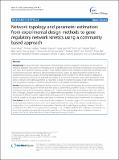Network topology and parameter estimation: from experimental design methods to gene regulatory network kinetics using a community based approach
Author(s)
Meyer, Pablo; Cokelaer, Thomas; Chandran, Deepak; Kim, Kyung H.; Loh, Po-Ru; Lipson, Mark; Berger, Bonnie; Kreutz, Clemens; Raue, Andreas; Steiert, Bernhard; Timmer, Jens; Bilal, Erhan; DREAM 6&7 Parameter Estimation consortium; Sauro, Herbert M.; Stolovitzky, Gustavo; Saez-Rodriguez, Julio; Tucker, George Jay; ... Show more Show less
Download1752-0509-8-13.pdf (2.945Mb)
PUBLISHER_CC
Publisher with Creative Commons License
Creative Commons Attribution
Terms of use
Metadata
Show full item recordAbstract
Background:
Accurate estimation of parameters of biochemical models is required to characterize the dynamics of molecular processes. This problem is intimately linked to identifying the most informative experiments for accomplishing such tasks. While significant progress has been made, effective experimental strategies for parameter identification and for distinguishing among alternative network topologies remain unclear. We approached these questions in an unbiased manner using a unique community-based approach in the context of the DREAM initiative (Dialogue for Reverse Engineering Assessment of Methods). We created an in silico test framework under which participants could probe a network with hidden parameters by requesting a range of experimental assays; results of these experiments were simulated according to a model of network dynamics only partially revealed to participants.
Results:
We proposed two challenges; in the first, participants were given the topology and underlying biochemical structure of a 9-gene regulatory network and were asked to determine its parameter values. In the second challenge, participants were given an incomplete topology with 11 genes and asked to find three missing links in the model. In both challenges, a budget was provided to buy experimental data generated in silico with the model and mimicking the features of different common experimental techniques, such as microarrays and fluorescence microscopy. Data could be bought at any stage, allowing participants to implement an iterative loop of experiments and computation.
Conclusions:
A total of 19 teams participated in this competition. The results suggest that the combination of state-of-the-art parameter estimation and a varied set of experimental methods using a few datasets, mostly fluorescence imaging data, can accurately determine parameters of biochemical models of gene regulation. However, the task is considerably more difficult if the gene network topology is not completely defined, as in challenge 2. Importantly, we found that aggregating independent parameter predictions and network topology across submissions creates a solution that can be better than the one from the best-performing submission.
Date issued
2014-02Department
Massachusetts Institute of Technology. Department of MathematicsJournal
BMC Systems Biology
Publisher
BioMed Central Ltd
Citation
Meyer, Pablo et al. “Network Topology and Parameter Estimation: From Experimental Design Methods to Gene Regulatory Network Kinetics Using a Community Based Approach.” BMC Systems Biology 8.1 (2014): 13.
Version: Final published version
ISSN
1752-0509